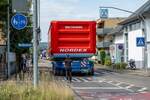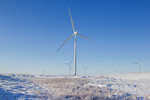02/14/2005
EU electricity transmission challenged by wind energy
Electricity generation from wind depends on weather conditions which can fluctuate a great deal more than with other renewable resources of energy such as hydraulic. "Since the electricity generated cannot be stockpiled, it is instantly transmitted on the network," explains Jean Verseille, the author of the industry forecast study from the French transmission system operator, RTE. Therefore, as the share of electricity generated from wind power in Europe increases, so do potential variations in supply, Verseille points out. In addition, variations can be worsened when national wind parks are concentrated in certain areas as is the case in northern Germany. Bordering countries dealing with high supply variations coming from the German network can be particularly affected as Germany is highly interconnected with the rest of Europe. This is less the case of Spain because it is connected to Europe through France, which then acts as a sort of buffer zone.
Recent forecasts from the Union for the Coordination of Transmission of Electricity (UCTE) in Europe point to new challenges for the security of electricity supply over the next decade (2005-2015). While UCTE predicts western and central Europe will not be at risk in 2005-2007, it warns the "full potential cannot be always tapped due to transmission system bottlenecks". UCTE therefore calls for increased investment in generation and transmission grids, saying 30 extra Giga Watts are needed to secure transmission operations by 2015. UCTE further points to the increasing challenge renewable energies pose to secure electricity transmission, especially in Spain and Germany which have high shares of wind power. However, the lack of co-ordination between European electricity transmission utilities, combined with their monopolistic situation in most countries, act as a break to the further development of wind and other renewables.
Jean Verseille, the author of the UCTE study from the French transmission system operator RTE, says high power variations can only be overcome through increased coordination among European network operators. "Production forecasts are a fundamental element" in improving coordination, says Verseille. However, he says coordination "should be reinforced" with better calculation and modelling tools. What needs to be done is "to build more network in order to evacuate production", an operation which he says takes "a certain amount of time". The developments, he adds, are particularly needed for countries with high share of wind power (Spain, Germany). In a recent press release, the European Wind Energy Association (EWEA) complained about transmission problems for wind energy. "The European market for wind energy has experienced average annual growth rates of 20% over the past six years; however, the further rapid progress that the industry is capable of delivering is constrained by barriers such as grid access and administrative hurdles," said Corin Millais, EWEA Chief Executive.
EWEA says technological solutions are already available for grid operators to accommodate the increased share of wind power in the EU electricity generation mix. However, EWEA also highlights the need for more reliable forecasts and network reinforcement as key to ensure that all wind power is properly fed into the network. A wider geographical distribution of wind installation is also a practical way highlighted by EWEA to compensate fluctuations: when wind does not blow up north, it might well be blowing down south. In a recent speech to MEPs on 24 January, President of the European Renewable Energy Council (EREC) Arthouros Zervos conveyed the same concerns, calling for "improvements to be made on the administrative sector and on problems related to grid access and transmission". Renewables, Zervos pointed out, are "well suited to reduce the dependence on energy imports".
Recent forecasts from the Union for the Coordination of Transmission of Electricity (UCTE) in Europe point to new challenges for the security of electricity supply over the next decade (2005-2015). While UCTE predicts western and central Europe will not be at risk in 2005-2007, it warns the "full potential cannot be always tapped due to transmission system bottlenecks". UCTE therefore calls for increased investment in generation and transmission grids, saying 30 extra Giga Watts are needed to secure transmission operations by 2015. UCTE further points to the increasing challenge renewable energies pose to secure electricity transmission, especially in Spain and Germany which have high shares of wind power. However, the lack of co-ordination between European electricity transmission utilities, combined with their monopolistic situation in most countries, act as a break to the further development of wind and other renewables.
Jean Verseille, the author of the UCTE study from the French transmission system operator RTE, says high power variations can only be overcome through increased coordination among European network operators. "Production forecasts are a fundamental element" in improving coordination, says Verseille. However, he says coordination "should be reinforced" with better calculation and modelling tools. What needs to be done is "to build more network in order to evacuate production", an operation which he says takes "a certain amount of time". The developments, he adds, are particularly needed for countries with high share of wind power (Spain, Germany). In a recent press release, the European Wind Energy Association (EWEA) complained about transmission problems for wind energy. "The European market for wind energy has experienced average annual growth rates of 20% over the past six years; however, the further rapid progress that the industry is capable of delivering is constrained by barriers such as grid access and administrative hurdles," said Corin Millais, EWEA Chief Executive.
EWEA says technological solutions are already available for grid operators to accommodate the increased share of wind power in the EU electricity generation mix. However, EWEA also highlights the need for more reliable forecasts and network reinforcement as key to ensure that all wind power is properly fed into the network. A wider geographical distribution of wind installation is also a practical way highlighted by EWEA to compensate fluctuations: when wind does not blow up north, it might well be blowing down south. In a recent speech to MEPs on 24 January, President of the European Renewable Energy Council (EREC) Arthouros Zervos conveyed the same concerns, calling for "improvements to be made on the administrative sector and on problems related to grid access and transmission". Renewables, Zervos pointed out, are "well suited to reduce the dependence on energy imports".
- Source:
- Online editorial, www.windfair.net
- Author:
- Trevor Sievert, Online Editorial Journalist
- Email:
- press@windfair.net
- Keywords:
- EU, Europe, Germany, Spain, France, wind energy, wind turbine, wind farm, rotor blade, onshore, offshore, energy transmission

























